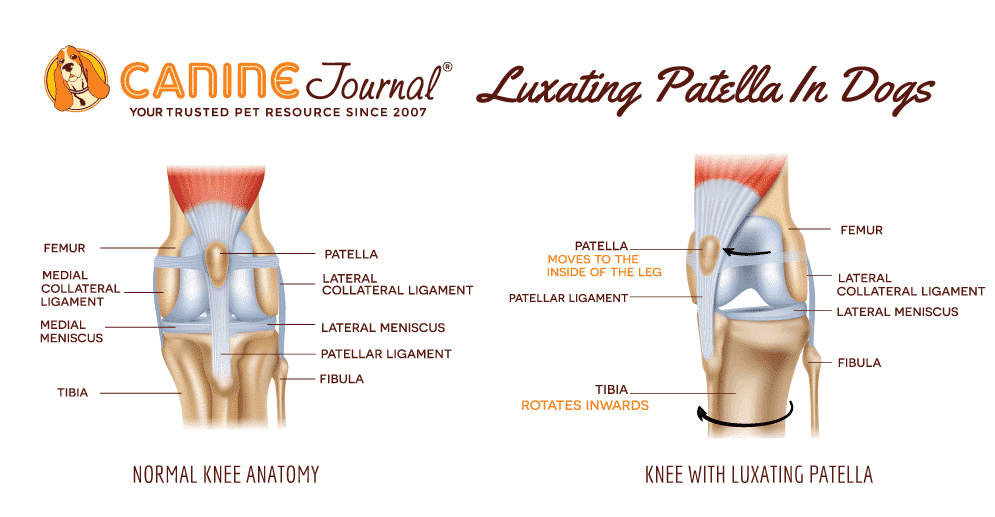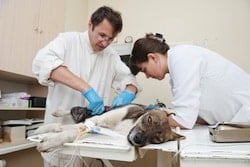
To keep the lights on, we receive affiliate commissions via some of our links. Our review process.

Have you noticed your dog occasionally hopping on one of his hind legs or walking on only three legs at times? If so, he could have a luxating patella, one of the most common orthopedic conditions in dogs.
How does this knee problem affect dogs? Is surgery the only option for this chronic condition, or are there other treatments? We’ll help you figure out what you need to do if you suspect your dog has an ongoing knee problem.
Article Overview
Contents
What Is Luxating Patella In Dogs?
The patella, or kneecap, normally sits in a groove at the lower end of the thigh bone (femur) and slides up and down in its groove when the knee flexes and straightens. But in dogs with a luxating patella, the kneecap shifts and dislocates outside of this groove when the knee flexes. The kneecap can shift toward the inside of the leg (termed medial luxation) or toward the outside of the leg (lateral luxation).
Patellar luxation ranges anywhere from mild, in which the kneecap only dislocates with manual pressure, to severe, in which the kneecap is permanently dislocated. See below for the different grades of luxating patella in dogs.
Patellar luxation is one of the dogs’ most common orthopedic conditions, diagnosed in nearly 7% of puppies. It occurs in the hind legs but not the front legs. In half of all cases, it affects both hind knees. While a traumatic injury can cause a luxating patella, most cases are congenital (present from birth) and hereditary.

Predisposed Breeds

The hereditary form of this condition is most common in small and toy dogs. However, cases are on the rise in some large breeds, which are now also considered predisposed to this condition, according to the American College of Veterinary Surgeons. Some of the most popular breeds affected include:
Small Breeds
- Bichon Frise
- Boston Terrier
- Cavalier King Charles Spaniel
- Chihuahua
- Jack Russell Terrier
- Maltese
- Miniature and Toy Poodle
- Pekingese
- Pomeranian
- Yorkshire Terrier
Large & Giant Breeds
- Akita
- Boxer
- Chinese Shar-Pei
- Golden Retriever
- Great Pyrenees
- Husky
- Irish Wolfhound
- Labrador Retriever
- Malamute
- St. Bernard
Luxating Patella Symptoms

Symptoms associated with patellar luxation vary depending on the severity of the disease. With a majority of dogs, the signs are fairly easy to spot. When the kneecap becomes dislocated, you may notice your dog hopping on his hind leg, holding it up, running on three legs, or stretching his leg out to try to pop the kneecap back in place. The affected limb may also lock-up in an odd position.
Once the kneecap pops back in place, dogs walk normally again on all four legs. But in most cases, this disease progresses over time, causing more frequent dislocations, cartilage damage, structural wear and tear, and arthritis. And this can become quite painful for your pup.
At What Age Do Symptoms Start?
Some puppies with severe medial patellar luxation appear bow-legged and show abnormal hind-leg function when they begin walking. But most dogs start showing signs between four and six months of age. Occasionally older dogs with a mild form of the disease may show sudden signs of lameness because the tissues have broken down over time.
Diagnosis & Grading
Veterinarians can typically diagnose patella luxation based on a physical exam. Be sure to share with your veterinarian if you’ve noticed your dog in pain from a dislocated kneecap so your vet can determine the best treatment plan. Veterinarians grade this condition based on the severity of the disease, ranging from grade I-IV, and may order X-rays to assess the grade and the level of cartilage damage.
Luxating Patella Grades
- Grade I: The kneecap dislocates only with manual pressure applied to it but returns to its normal position on its own when pressure is released.
- Grade II: The kneecap intermittently shifts out of its normal position but can pop back in place manually or when the dog straightens out the joint.
- Grade III: The kneecap is permanently out of place. It can be manually returned to its normal position but will then pop right back out.
- Grade IV: The kneecap is permanently dislocated and can’t be manipulated back in place.
Luxating Patella Dog Treatment

Dogs with grade I patellar luxations and some with minor grade II don’t require surgery (it depends on how often dislocations occur). There are several ways to manage and treat this condition if minor without surgery, which we explain below. Dogs with grades III and IV require surgery, and it’s often recommended for grade II as well.
Luxating Patella Surgery
The specific techniques used in surgery depend on the severity of the disease and any structural abnormalities present. Your pup’s surgeon may use one or more of these strategies to correct the luxating patella.
- Reconstructing the soft tissues surrounding the kneecap. This loosens the side toward which the patella is moving when dislocated and tightens the opposite side to help keep the kneecap in place.
- Deepening the groove in the femur so the kneecap will stay in its normal position (a technique called sulcoplasty).
- Adjusting the location where the patellar tendon attaches to the shin bone (tibia) to its proper position (a procedure called tibial tubercle transposition). This helps realign the quadriceps, the kneecap, and its tendon.
- In severe cases where the femur is abnormally shaped, a surgeon will straighten the femur. This procedure (called femoral varus osteotomy) involves cutting the bone, correcting its deformity, and securing it with a bone plate and screws.
How Much Does Luxating Patella Surgery Cost?
Unfortunately, surgery is expensive, ranging from $1,500 to $3,000 per knee. You’ll also need to factor in the cost of the diagnostics and medication to manage post-operative pain.
Recovery & Prognosis
Recovery time from patella luxation surgery is normally 8–10 weeks. Your pup’s surgeon will give you specific instructions to manage your dog’s surgical site and activity during recovery.
The success rate of luxating patella surgery in dogs is about 90%. Once recovered from surgery, most dogs will be fully functional. In about 10% of cases, the luxation recurs and may need further treatment.
Non-Surgical Treatment
Many dogs with grade I don’t require any specific treatment. Non-surgical treatment for grade II dogs can include pain and anti-inflammatory medications, physical therapy, exercise restriction, and weight management.
You may wonder if there are any home remedies for luxating patella in dogs. You can do several things for your pup to promote healthy tissue, joints, and bones.
Diet & Weight Management
Make sure you give your dog a healthy diet full of whole meats, vitamins, and minerals to maintain lean, strong muscles and support ligaments, joint tissues, and bones. You may want to consider a fresh meal delivery service to get high-quality, healthy food for your pup. It’s also extremely important to manage your dog’s weight as excess pounds can put a lot of strain on your pup’s knees.
Nutritional Supplements

Giving your dog nutritional supplements can also help with luxating patella. Fish oil contains omega fatty acids that help reduce inflammation and pain and may help slow the progression of arthritis. Other effective supplements for joint health include glucosamine, chondroitin sulfate, and methylsulfonylmethane (MSM). We recommend PetHonesty’s Advanced Hip & Joint supplement, which combines all three.
Exercise
Although dogs with a luxating patella should restrict strenuous exercise, daily walks are still crucial. Walking helps keep your dog’s muscles strong, can help prevent arthritis, and is important to maintain a healthy weight. It’s better to go on several short walks per day rather than longer walks to reduce the strain on your pup’s knees.
Dog Knee Brace
You may also want to consider getting a dog knee brace for luxating patella, which can help restrict your dog’s joint movement when he’s on walks. The Ortocanis Original Knee Immobilizer is designed for dogs with patella dislocation and ACL tears. It has a lateral aluminum splint to increase your pup’s stability and reduce joint movements. It comes in nine different sizes for either the right or left hind leg.
Dog Massage & PT Exercises For Luxating Patella: Video Tutorial
Dog massage and physical therapy exercises can be extremely beneficial for post-surgery pups and dogs with a mild-grade luxating patella. Hydrotherapy can also be helpful. In this four-minute video, a veterinarian shows you an excellent routine you can do at home to help your pup.
Frequently Asked Questions
Here are some of the questions our readers ask most often about patella luxation.
Can Puppies Grow Out Of A Luxating Patella?
Unfortunately, no, puppies can’t grow out of a luxating patella.
Should You Walk A Dog With A Luxating Patella?
Walking a dog with grade I and minor grade II patella luxation can help prevent arthritis and keep your dog in shape, although exercise should be low-impact. Hydrotherapy is also beneficial. Also, it’s important to walk your dog once he’s recovered from surgery to help keep his joints healthy.
Talk to your vet if you’re unsure how much exercise to give your dog suffering from patella luxation.
Can You Prevent A Luxating Patella?
The only way to prevent patella luxation is to avoid breeding dogs that suffer from this condition.
What Other Conditions Can Have Similar Signs?
Other common orthopedic conditions in dogs that can cause hind leg problems with somewhat similar symptoms include an ACL tear and hip dysplasia.
Does Pet Insurance Cover Luxating Patella Surgery?
Yes, pet insurance can cover knee surgery for dogs with patellar luxation. However, because a luxating patella typically presents itself at a young age, it’s best to enroll your dog in pet insurance at the earliest age possible (most providers start enrollment at eight weeks of age) to increase your chances of having it covered.
Another thing to consider is that a couple of pet insurance companies have additional waiting periods for orthopedic conditions. So even if you sign your dog up for pet insurance at eight weeks old, luxating patella surgery wouldn’t be eligible for coverage until the orthopedic waiting period has passed. However, most companies don’t have this additional waiting period, but it is something to keep in the back of your mind when choosing a pet insurance provider.
One final note is that luxating patellas are sometimes included under bilateral exclusions in pet insurance policies. This means that if you sign up for pet insurance after your dog is diagnosed with a luxating patella in one of his rear legs, then his other rear leg wouldn’t be eligible for coverage if this second diagnosis occurs. This is another reason to start your research now and sign up for pet insurance as soon as possible.
How Can Pet Insurance Help Me And My Pup?
You may want to consider signing up for pet insurance early in your pup’s life. This proactive measure can lower your financial risk associated with potential health threats, like expensive luxating patella surgery, during your dog’s lifetime. It also helps if your pup has a costly accident. And, let’s be honest, puppies get into so much trouble, there is a good chance you will end up at the vet’s office more than you planned in the early years.
Many top pet insurance providers offer coverage for puppies as young as eight weeks old (and some as early as six week). You can learn more about pet insurance and see how the companies differ by reading our pet insurance reviews.
Tagged With: Orthopedic